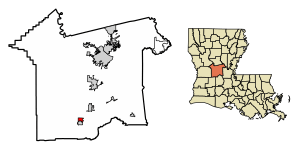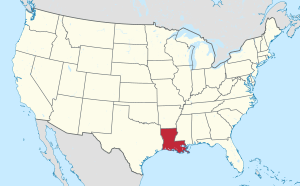McNary, Louisiana facts for kids
Quick facts for kids
McNary, Louisiana
|
|
|---|---|
|
Village
|
|
| Village of McNary | |

Location of McNary in Rapides Parish, Louisiana.
|
|

Location of Louisiana in the United States
|
|
| Country | United States |
| State | Louisiana |
| Parish | Rapides |
| Area | |
| • Total | 1.87 sq mi (4.85 km2) |
| • Land | 1.84 sq mi (4.77 km2) |
| • Water | 0.03 sq mi (0.07 km2) |
| Elevation | 125 ft (38 m) |
| Population
(2020)
|
|
| • Total | 201 |
| • Density | 109.12/sq mi (42.13/km2) |
| Time zone | UTC-6 (CST) |
| • Summer (DST) | UTC-5 (CDT) |
| Area code(s) | 318 |
| FIPS code | 22-47315 |
McNary is a small village located in Rapides Parish, Louisiana, in the United States. It is part of the larger Alexandria area. In 2020, about 201 people lived there. McNary started as a special town built by a lumber company. It had many things like a hospital, stores, a theater, and even a swimming pool. When the lumber ran out, the company moved its entire operation to McNary, Arizona. Even though the lumber company left, the village of McNary in Louisiana kept going.
Contents
History of McNary
How McNary Began
Around the 1880s, railroads started to arrive in Louisiana. This led to a big boom in the lumber industry. Louisiana had huge forests of pine trees, covering most of the state. There were also many cypress trees in swampy areas. Like many towns built along the new railroads, McNary started because of the lumber business.
William M. Cady of the Cady Lumber Company, along with Alfred Smith and James McNary, set up a large lumber mill here. Soon, a town grew around the mill. About 3,000 people lived in McNary. It had many things you would find in bigger towns, like a theater, a hospital, and a swimming pool.
The Lumber Mill Moves
By the early 1920s, many lumber mills started to run out of trees to cut. By 1923, the forests around McNary were mostly used up. What happened next was quite unusual. The Cady Lumber Company bought another lumber company in Arizona. They bought new pine forests, a railway, and a sawmill in a place called Cooley, Arizona.
Then, they moved the entire McNary mill! They even moved people on a special train with twenty-one coaches. The new lumber town in Arizona was then named McNary, Arizona.
McNary Survives
After the lumber mill left, the community in Louisiana faced tough times. However, it did not become a ghost town. In 1929, the town's official charter became inactive. But in 1965, the charter was reactivated, meaning McNary became an official village again. Today, you can still see parts of the old Cady mill in the area.
Population Facts
| Historical population | |||
|---|---|---|---|
| Census | Pop. | %± | |
| 1920 | 1,318 | — | |
| 1930 | 211 | −84.0% | |
| 1940 | 151 | −28.4% | |
| 1970 | 220 | — | |
| 1980 | 240 | 9.1% | |
| 1990 | 248 | 3.3% | |
| 2000 | 211 | −14.9% | |
| 2010 | 211 | 0.0% | |
| 2020 | 201 | −4.7% | |
| U.S. Decennial Census | |||
In 2000, there were 211 people living in McNary. These people lived in 76 households, and 56 of those were families. The village had 93 housing units.
Most people in McNary were White (85.31%). About 10.43% were African American. A small number of people were Native American (0.47%), Asian (0.95%), or from other races (2.84%). About 0.95% of the population was Hispanic or Latino.
Who Lives in McNary?
In 2000, about 40.8% of households had children under 18 living with them. Most households (59.2%) were married couples. About 10.5% of households had a female head with no husband. About 23.7% of all households were made up of single people. About 13.2% of households had someone living alone who was 65 years old or older.
The average household had about 2.78 people. The average family had about 3.36 people.
Age Groups
The people in McNary were of different ages:
- 30.8% were under 18 years old.
- 8.5% were between 18 and 24 years old.
- 27.5% were between 25 and 44 years old.
- 20.4% were between 45 and 64 years old.
- 12.8% were 65 years old or older.
The average age in McNary was 37 years. For every 100 females, there were about 101 males.
See also
 In Spanish: McNary (Luisiana) para niños
In Spanish: McNary (Luisiana) para niños

